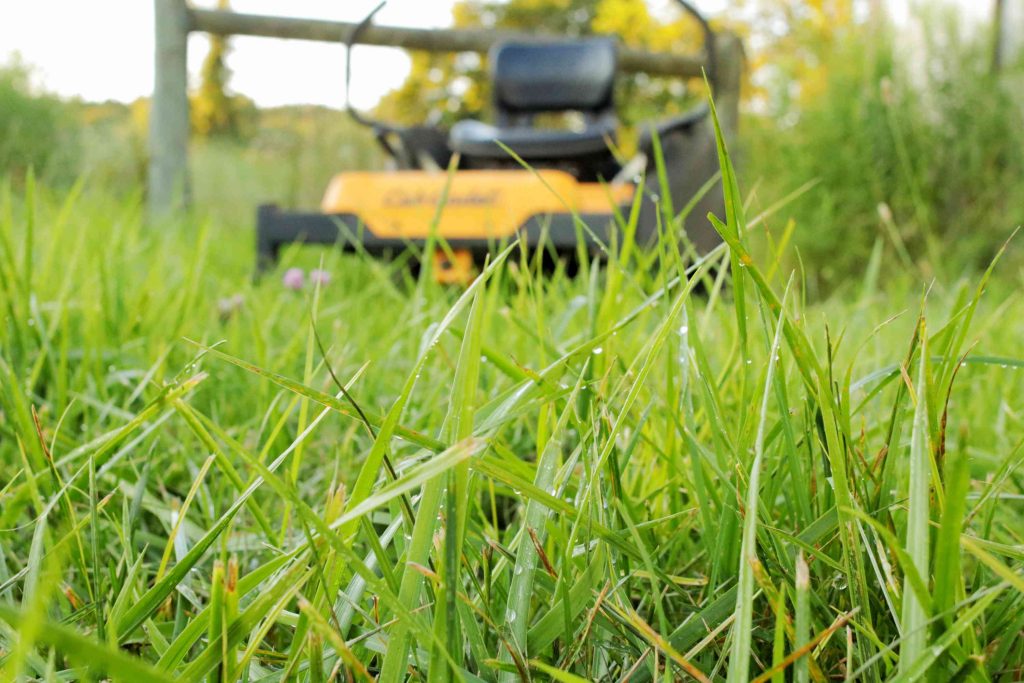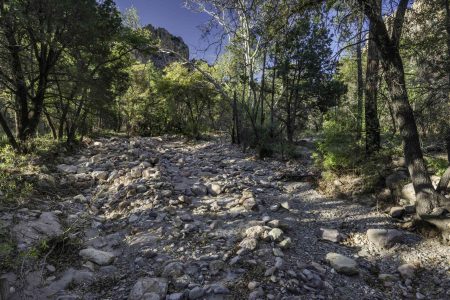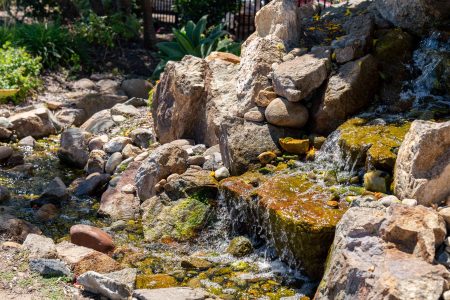There are many reasons why mowing wet grass is a bad idea, and it’s not only heavy rainstorms that pose a problem. Lighter rains are enough to create conditions less than ideal for cutting lawns. While early-morning mowing may be a great fit for your schedule, the dew on the lawn is enough to make it a big mistake for your landscaping.
Cutting Wet Grass Can Hurt Your Lawn
For an ideal cut, grass blades should be standing up off the ground. Wet blades of grass are heavier than dry ones. For this reason, such blades hug the ground. As your turf starts to dry after a rain, some of the blades will, indeed, resume their upright position and be chopped off when you mow, but the rest will not be standing at attention and your mower will pass right over them rather than cutting them. When they do pop back up, your lawn will be riddled with “cowlicks.”
The resulting uneven look would be bad enough, but when you try to cut damp grass—the result is a tear rather than a clean cut. These tears open the door for fungus and moisture provides a medium for fungus to spread, so when you mow a lawn that’s wet, you’re creating a perfect storm for fungal infestations.
Fungal diseases can also develop on a lawn that has been cut after a rainstorm through the grass clippings, which form bigger clumps under such conditions. These clippings mat down, restricting healthy airflow. An excess of grass clippings that fall on your lawn can lead to a fungal disease known as “brown spot.” Meanwhile, the wet grass clippings that stick to the underside of the mower deck—if allowed to remain there—invite mold, which can then be spread to your turf.
Finally, even the simple act of making passes up and down a wet lawn with your machine can hurt your lawn. The wheels sink down into a moist surface in a way that they won’t when the ground is dry. At worst, the wheels will form ruts in the surface, directly damaging the grass. At best, they will cause the soil to become compacted, which causes damage over time.
It’s Not Good for Your Mower, Either
Though it is okay to run a gas-powered mower in the rain, you should avoid storing the mower outside in the rain. Moisture is problematic for the gasoline in the mower’s fuel tank, its metal parts, and, indirectly, its engine. If you don’t mix a stabilizer into the fuel tank, intruding moisture and condensation causes corrosion. Fuel contamination happens when the gasp cap is opened while the mower is outdoors when it’s raining.
Moist grass clippings that cake on the metal underside could eventually cause rust. Even in the short term, the presence of this caked substance stresses the engine—
Warning
Use extreme caution with both corded or cordless battery-powered electric mowers in wet weather. Do not use electrical equipment, such as a corded electric mower, to mow wet grass or you run the risk of serious injury to yourself. In addition, mowing a wet lawn with a cordless electric mower (battery only) can potentially harm the battery and internal wiring if water leaks inside.
Most Importantly, It’s Unsafe
Your personal safety must always come before getting work done in the yard and you’re at greater risk of injury when mowing wet grass than dry grass. There are two factors that can escalate the risk:
- Using an electric mower
- Mowing on slopes
One way to eliminate the latter is to grow ground covers on slopes instead of grass.
Regardless of the terrain and the type of mower you use, there’s some danger of slipping on slick turf. It could easily cause you to pull a muscle, but even breaking a bone isn’t out of the question. The worst possible scenario is that, in losing control of your body in the slippery conditions, one of your limbs falls into the path of the rotating blade.
Mowing a Wet Lawn Causes You Extra Work
It takes more time and effort to mow a wet lawn, and because your lawn still won’t look very good afterward, you’ll want to mow all over again as soon as possible. In addition, wet grass stains your clothes, shoes, and every surface your shoes touch, so cleaning up afterward is worse. However, all of this is just the beginning of the added work, which comes mainly in the form of all the adjustments you’ll have to make compared to normal mowing.
In Case You Must Mow When the Lawn Is Wet
Sometimes, you’ll feel compelled to cut the grass despite its being wet, and with full knowledge of all the reasons why mowing at such a time is problematic. For example, maybe:
- There has been an extended period of rain in your area, with even more rain forecasted, and you know waiting longer to mow would mean the grass would get much taller than it’s supposed to.
- You have put your property on the real-estate market and are showing it today, and your yard has to be at its aesthetic best.
Yes, you can mow in such cases if you truly must, as long as the ground isn’t downright soggy—you shouldn’t be sinking down into it or standing in puddles—but you should make some adjustments:
- Add stabilizer to your gasoline.
- Safely sharpen your mower blade.
- Raise your mower wheels; mowing higher than normal will put less stress on the engine.
- Don’t try mulching or bagging the grass (with a wet lawn, mulching doesn’t work as well, and the inside of your bag would get terribly dirty): Just discharge it out the side chute.
- On each pass, you make while mowing, cut only half the swath you normally would. This way, the engine doesn’t have to work as hard.
- Safely clean the underside of the mower’s deck and the discharge chute as you go, so that fewer clippings cake onto them (spraying silicone onto a clean deck beforehand may make the scraping go easier).
- Rake up those clippings afterward and move them to your compost bin.
You can also take a proactive approach. Listen to weather forecasts to stay informed about approaching rainstorms. When you know one is coming, mow your grass before it can get wet even if it wouldn’t normally be time to mow yet.
Read the full article here









